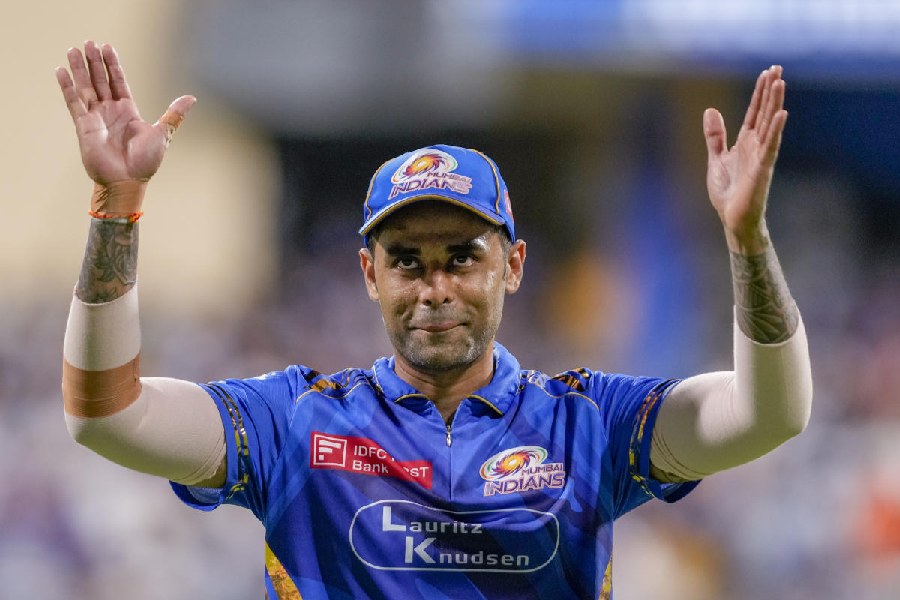|
|
| Fragile aggro |
This article is not going to make me very popular among Bengalis. I can only hope that the handful of cricket lovers who are willing to place the game of cricket above patriotic sentiments will agree with some of the things I am saying.
What will make me unpopular is the fact that I am launching a criticism on the current favourite Bengali icon, Sourav Ganguly. The latter has been put on such a pedestal that a punishment meted out to him on the cricket field has been interpreted, in certain circles, as a national affront. Even the chief minister of West Bengal, Buddhadeb Bhattacharjee, whose understanding of cricket is only a shade below his comprehension of Das Kapital, pronounced on the unfairness of the verdict.
Let us look at the facts of the case. Ganguly was banned for six one-day internationals because he failed to maintain the required over rate. That he failed to get his bowlers to bowl the required quota of overs within the specified period of time is beyond question. According to the laws pertaining to ODIs, the match referee adjudicates on matters relating to slow over rate.
One of the unwritten assumptions by which the game of cricket is played is that players will accept the decision of umpires and referees as final. In the case of match referees, a special provision has been made for appeals. Even before the issue went on to an appeal, a hue and cry was raised and Chris Broad, the match referee, was hung and quartered.
Some people even went to the extent of saying that Broad?s decision had been influenced by racist considerations. One observer suggested that such a harsh verdict would never be meted out to Ricky Ponting. What was ignored in such comments is the fact that the Australian side, a truly professional team, if ever there was one, has hardly ever maintained a slow over rate. We rarely notice how quickly the Aussies change sides between overs, and how leisurely the Indian eleven performs the same routine. It is the captain?s responsibility to speed things up. If he fails, he should take the rap on behalf of the team. He should take the rap as behoves a cricketer, not bleat about it.
This raises a very fundamental question. Does Ganguly behave like a cricketer? The answer, I am afraid, is no. Look at the number of times he has shown his dissent on the field over a decision that has gone against him. There have been at least three occasions in the recent past when his show of displeasure has been so bad and so blatant that he had to be penalized by the match referee. Some other instances have gone unpunished. Here, Ganguly time and again and without shame violated one of the cardinal principles on which the game of cricket is based. That principle states that the umpire?s decision is always final and should be accepted without question. There is no point making the argument that other batsmen also show their displeasure at umpires these days. As the saying goes, two wrongs do not make a right. A violation of cricketing ethics is a violation, no matter who makes it.
It is often said, by the Ganguly fan brigade, that as captain, he injected much-needed aggression into the Indian team. It is already clear how fragile that aggro is. The high fives, the screams and the jumping on each other, led invariably by Ganguly after the fall of every wicket, become irrelevant and something of a sick joke when the team does not perform. And the team has not been performing for quite some time. The high point of this exhibition of aggression was the sight of the Indian captain at Lord?s, bare bodied and waving his shirt like a soccer lout. Somebody should have told him that there is a distinction between being a spoilt brat and being captain of India. More often than not, Ganguly has set a bad example for the boys.
If his behaviour on the field and on the Lord?s verandah as a captain was not exemplary, the story of his leadership through his performance dwindles to the pathetic. Ganguly, seldom, if ever, led from the front. His batting form reduced him to the position of liability to the side. The statistics speak for the batsman. In the last 25 test innings, stretching from 2002-03 to now, Ganguly has two hundreds. His last hundred was 144 against Australia in 2003-04. The last time he has crossed 25 is in 2004-05 against Bangladesh when he made 88. He crossed 50 seven times, including the two centuries. This is not exactly the record of a top class test batsman.
The picture does not improve in the statistics for ODIs. In the last 25 innings, from 2003-04 to the present, he made no centuries. He was twice dismissed at 90. Other than these two knocks, he crossed 50 only on four outings and 25 only five times. For those who believe that numbers say everything in cricket, these speak volumes about Ganguly?s performance.
Some other facts are even more revealing for those interested in the technical aspects of batsmanship. In the 25 test innings being discussed here, he was out caught 14 times. For the ODIs under discussion, Ganguly was out caught all of 17 times. This suggests that Ganguly?s batting technique has serious flaws which the opposition is exploiting. I would not be surprised if the bulk of these catches were behind or square of the wicket on the off side. Ganguly plays wide apart from his body; his feet do not move and he is virtually immobile on the leg side. That he at all gets any runs is surprising.
He is always vulnerable against fast bowlers, especially outside the off stump and to deliveries coming into his body. It is difficult to believe that these drawbacks have not been pointed out to Ganguly or that he himself has not picked the flaws out while watching his own batting on video. But he refuses to learn. This might be related to his air of arrogance which leads to his innumerable and inexcusable violation of the spirit of the game.
Given the fact that very few decisions in Indian cricket are made on the basis of merit, it is likely that Ganguly will return to the Indian team, may be even as captain. What is unlikely is that the return will be marked by either grace or humility.












